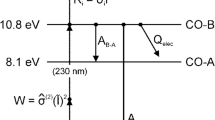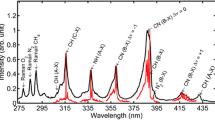Abstract
The paper presents the results of simulation and experimental study on the efficiency of selecting a pair of excitation lines of OH hydroxyl radical for the (1−0) transition for the A2Σ+−X2Π system for local temperature measurement in a hydrocarbon flame. The LASKIN software was used for the numerical simulation. The temperature field for a laminar methane-air premixed flame (with equivalence ratio equal 1.1) at the atmopsheric pressure was measured. Different combinations of literature-recommended pairs of excitation lines were considered. The results of numerical simulation agree with a theoretical dependency for the temperature range of 1200–2100 K for the coupled excitation lines Q1(5):Q1(14) and Q1(5):Q2(11). However, a moderate discrepancy is observed for the pairs R2(2):R2(13) and R2(2):R2(10). It is concluded that the coupled excitation of Q1(5):Q1(14) and R2(2):R2(13) lines provide a higher sensitivity to the temperature variation. The benefit of the latter pair is that these transitions correspond to close values of the excitation wavelengths in the vicinity of 282 nm. Therefore, this can be convenient for the arrangement of experiments.
Similar content being viewed by others
References
A. Fayoux, K. Zähringer, O. Gicquel, and J. Rolon, Experimental and numerical determination of heat release in counterflow premixed laminar flames, Proceedings of the Combustion Institute, 2005, Vol. 30, No. 1, P. 251–257.
B.O. Ayoola, R. Balachandran, J.H. Frank, E. Mastorakos, and C.F. Kaminski, Spatially resolved heat release rate measurements in turbulent premixed flames, Combustion and Flame, 2006, Vol. 144, Nos. 1–2, P. 1–16.
R.L. Gordon, A.R. Masri, and E. Mastorakos, Heat release rate as represented by [OH]×[CH2O] and its role in autoignition, Combustion Theory and Modelling, 2009, Vol. 13, No. 4, P. 645–670.
E.R. Lachney and N.T. Clemens, PLIF imaging of mean temperature and pressure in a supersonic bluff wake, Experiments in Fluids, 1998, Vol. 24, No. 4, P. 354–363.
T. Lee, W.G. Bessler, H. Kronemayer, C. Schultz, and J.B. Jeffries, Quantitative temperature measurements in high-pressure flames with multiline NO-LIF thermometry, Applied Optics, 2005, Vol. 44, No. 31, P. 6718–6728.
W.G. Bessler and C. Schulz, Quantitative temperature measurements in high-pressure flames with multiline NO-LIF thermometry, Applied Optics, 2005, Vol. 44, No. 31, P. 6718–6728.
R. Giezendanner-Thoben, U. Meier, W. Meier, and M. Aigner, Phase-locked temperature measurements by two-line OH PLIF thermometry of a self-excited combustion instability in a gas turbine model combustor, Flow, Turbulence and Combustion, 2005, Vol. 75, No. 1–4, P. 317–333.
B. Ayoola, G. Hartung, C.A. Armitage, J. Hult, R.S. Cant, and C.F. Kaminski, Temperature response of turbulent premixed flames to inlet velocity oscillations, Experiments in Fluids, 2009, Vol. 46, No. 1, P. 27–41.
B.R. Halls, P.S. Hsu, S. Roy, T.R. Meyer, and J.R. Gord, Two-color volumetric laser-induced fluorescence for 3D OH and temperature fields in turbulent reacting flows, Optics Letters, 2018, Vol. 43, No. 12, P. 2961–2964.
R. Devillers, G. Bruneaux, and C. Schulz, Development of a two-line OH-laser-induced fluorescence thermo-metry diagnostics strategy for gas-phase temperature measurements in engines, Applied Optics, 2008, Vol. 47, No. 31, P. 5871–5885.
S. Kostka, S. Roy, P.J. Lakusta, T.R. Meyer, M.W. Renfro, J.R. Gord, and R. Branam, Comparison of line-peak and line-scanning excitation in two-color laser-induced-fluorescence thermometry of OH, Applied Optics, 2009, Vol. 48, No. 32, P. 6332–6343.
J.M. Seitzman, R.K. Hanson, P.A. DeBarber, and C.F. Hess, Application of quantitative two-line OH planar laser-induced fluorescence for temporally resolved planar thermometry in reacting flows, Applied Optics, 1994, Vol. 33, No. 18, P. 4000–4012.
E.J. Welle, W.L. Roberts, C.D. Carter, and J.M. Donbar, The response of a propane-air counter-flow diffusion flame subjected to a transient flow field, Combustion and Flame, 2003, Vol. 135, No. 3, P. 285–297.
A. Bülter, U. Lenhard, U. Rahmann, K. Kohse-Höinghaus, and A. Brockhinke, Laskin: Efficient simulation of spectra affected by energy transfer, Proceedings of Laser Applications to Chemical and Environmental Analysis (9 February 2004), Optical Society of America, USA, 2014. Paper TuE4.
G.H. Dieke and H.M. Crosswhite, The ultraviolet bands of OH fundamental data, J. Quantitative Spectroscopy and Radiative Transfer, 1962, Vol. 2, No. 2, P. 97–199.
F. Rabenstein and A. Leipertz, Two-dimensional temperature determination in the exhaust region of a laminar flat-flame burner with linear Raman scattering, Applied Optics, 1997, Vol. 36, No. 27, P. 6989–6996.
F. Rabenstein and A. Leipertz, One-dimensional, time-resolved Raman measurements in a sooting flame made with 355-nm excitation, Applied Optics, 1998, Vol. 37, No. 21, P. 4937–4943.
D.K. Sharaborin, D.M. Markovich, and V.M. Dulin, Planar spontaneous Raman-scattering spectroscopy for reacting jet-flow diagnostics using Lyot-Ehman tunable filter, Techn. Phys. Letters, 2018, Vol. 44, No. 1, P. 53–56.
Author information
Authors and Affiliations
Corresponding author
Additional information
Research was supported by the Ministry of Education and Science of Russia, Agreement No. 075-15-2020-806.
Rights and permissions
About this article
Cite this article
Lobasov, A.S., Tolstoguzov, R.V., Sharaborin, D.K. et al. On the efficiency of using different excitation lines of (1−0) two-line OH fluorescence for planar thermometry. Thermophys. Aeromech. 28, 751–755 (2021). https://doi.org/10.1134/S0869864321050176
Received:
Revised:
Accepted:
Published:
Issue Date:
DOI: https://doi.org/10.1134/S0869864321050176




